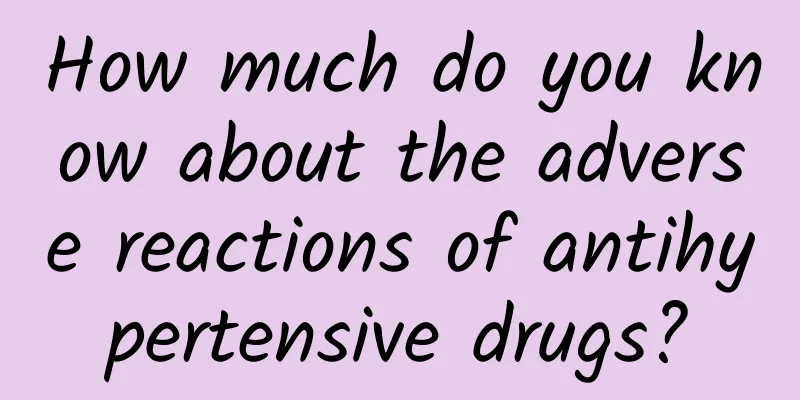How much do you know about the adverse reactions of antihypertensive drugs?

|
The normal blood pressure of a normal person is usually below 120/80. When the systolic pressure is greater than or equal to 140 mmHg and the diastolic pressure is greater than 90 mmHg, it is considered hypertension. |||| In recent years, the prevalence of hypertension in my country has generally shown an increasing trend. Hypertension has many harmful effects. It often causes organic changes in organs such as the heart, blood vessels, brain, and kidneys, leading to systemic diseases such as coronary heart disease, heart failure, and stroke. It has been clearly established that there is a causal relationship between hypertension and hypertension [1]. Therefore, once it is discovered, it should be actively treated. In addition to improving lifestyle, drug therapy plays an important role in hypertension. As the most common chronic disease, antihypertensive drugs are widely used and there are many types. So what kind of antihypertensive drugs should hypertensive patients use? This requires doctors and pharmacists to choose based on the patient's condition, drug efficacy, and adverse reactions. Hypertensive patients should also pay attention to their own conditions and report to doctors and pharmacists in a timely manner to help them choose, so as to achieve the purpose of individualized treatment and rational use of drugs. The most common antihypertensive drugs on the market are divided into five categories according to their mechanism of action. Different mechanisms of action lead to different adverse reactions. We can distinguish the drug categories based on the drug names and be alert to the occurrence of adverse reactions of different types of antihypertensive drugs. 1. Calcium channel blockers (generic name: xxxdipine) Common drugs include amlodipine besylate (Norvasc), felodipine sustained-release tablets (Boeding), and nifedipine controlled-release tablets (Baixintong). This type of drug blocks calcium ions from entering cells, relaxes vascular smooth muscle, reduces vascular resistance, and achieves a blood pressure-lowering effect. However, because it dilates blood vessels, it is easy to cause facial flushing, edema of the extremities, and palpitations [2]. In addition, adverse reactions of the digestive system such as abdominal pain, nausea, and vomiting may also occur. Adverse reactions such as rash and itching are occasionally seen. 2. Angiotensin receptor antagonist (generic name: xxsartan) Common drugs include losartan potassium tablets (Cosartan), valsartan capsules (Diovan), olmesartan medoxomil tablets (Olmesartan), irbesartan tablets (Ambrovi), telmisartan tablets (Micardis), and olisartan medoxomil (Xinlitan). This class of drugs blocks the angiotensin II receptors, thereby blocking the effects of angiotensin in constricting blood vessels and raising blood pressure. The overall incidence of adverse reactions is very low and mild, with occasional rashes and increased blood potassium. Other possible adverse reactions include palpitations, dizziness, cough, hypotension, etc. 3. Angiotensin converting enzyme inhibitors (generic name: xxpril) Common drugs include enalapril (Esutapril), perindopril (Yashida), benazepril (Lotensin, Xindayi), and fosinopril (Monor). This type of drug inhibits the production of angiotensin by inhibiting angiotensin converting enzyme, thereby blocking the effect of angiotensin on vasoconstriction and increasing blood pressure. However, this type of drug also inhibits the degradation of bradykinin. Undegraded bradykinin is prone to cause irritating dry cough, which is the most common adverse reaction of this type of drug [3]. Other adverse reactions are similar to those of angiotensin receptor antagonists, and occasionally itching, rash, hair loss, hypotension, etc. 4. Beta-blockers (generic name: xxlol) Common drugs include metoprolol tartrate tablets (Betaloc), bisoprolol fumarate tablets (Bosu, Kangxin), etc. This type of drug works by inhibiting the beta receptors on vascular smooth muscle, reducing sympathetic nerve activity, and thus relaxing blood vessels and lowering blood pressure. Since the sympathetic nerve activity is inhibited, it can also cause a slowing of the heart rate. Patients should pay attention to changes in heart rate when taking the drug. Hypertensive patients with bradycardia are prohibited from using the drug. Beta receptors are not only found in vascular smooth muscle, but also in bronchial smooth muscle, which can cause bronchial contraction. Therefore, patients with asthma and chronic obstructive pulmonary disease should not use the drug, otherwise it is very likely to cause an attack of the disease. 5. Diuretics In clinical practice, hydrochlorothiazide is mainly used to lower blood pressure. It is rarely used alone and is often used in combination with other types of antihypertensive drugs to form a compound preparation, such as valsartan hydrochlorothiazide tablets (Valsartan Hydrochlorothiazide Tablet ... The most common adverse reactions of hydrochlorothiazide are water and electrolyte disorders, which can easily lead to hypokalemia. Long-term hypokalemia may lead to alkalosis, muscle cramps, ectopic heart rhythm and other changes, so you must be vigilant. At the same time, hydrochlorothiazide can easily cause increased uric acid and blood sugar, so patients taking this type of drug should pay attention to regular biochemical examinations to understand their own changes. Patients with hyperuricemia and diabetes should avoid using it. We can completely avoid adverse reactions by formulating a reasonable medication plan. As doctors and pharmacists, we should fully understand the contraindications and indications of antihypertensive drugs, formulate differentiated drug treatment plans based on the specific conditions of the patients, and strengthen patient guidance. As a patient, you should know what kind of medicine you are taking, pay attention to possible adverse reactions, communicate with doctors and pharmacists in time, and do not stop taking the medicine or change the dosage on your own. Only by using medicine rationally can you better protect your health. 【References】 [1]. Guidelines for the prevention and treatment of hypertension in China (revised edition 2018). Chinese Journal of Cardiology, 2019. 24(01): pp. 24-56. [2]. Cao Li, Analysis of common adverse drug reactions and rational drug application effects in hypertension. Northern Pharmacy, 2018. 15(08): p. 157. [3]. Lu Jianfang, Tan Jianhua and Zou Yongqiang. Monitoring and analysis of adverse reactions of three commonly used antihypertensive drugs. Journal of Prevention and Treatment of Cardiovascular and Cerebrovascular Diseases, 2014. 14(05): pp. 401-403. |
>>: Early identification, standardized diagnosis and treatment of ADHD in children
Recommend
What are the functions of Millettia reticulata? What are the benefits of wearing Millettia reticulata for a long time?
Millettia reticulata is another name for many pla...
Symptoms of blood stasis in women
How to eliminate blood accumulation in women’s bo...
Treatment and health care of postpartum pubic separation
Many women experience pubic separation and pubic ...
Don’t be a “devil boy” during the winter vacation, and don’t be a “salted fish” when school starts! Nezha teaches you how to concentrate your mind and three heads and six arms
School has started, and the winter vacation has b...
Winning works of the first Ningxia middle school student science fiction essay competition: The superstar among vegetables - sweet potato
Editor: Kang Yan Reviewer: Yang Pengbin (Li Wei, ...
What are the clinical characteristics of breast fibroids?
Breast fibroma is a type of benign breast tumor, ...
Detailed explanation of the symptoms and prevention methods of mixed vaginitis!
Mixed vaginitis is an inflammatory disease caused...
The reason why girls often have stomachaches
Girls' bodies are generally more fragile than...
What does it feel like when the blastocyst implants?
Some families may be anxious to have a baby, and ...
What are the symptoms and reactions of pregnancy
During pregnancy and when you can't get pregn...
What causes girls to have flat chests during puberty?
Puberty is a period of rapid physical development...
What supplements should I take for uterine fibroids
Uterine fibroids are a kind of female gynecologic...
Can you eat hen during menstruation?
Hen is a very common food ingredient. There are m...
Is it normal to have a period that ends in two days?
For girls, each menstruation usually lasts 4-7 da...
What causes vaginal pain?
This type of vaginal pain is more common in women...









